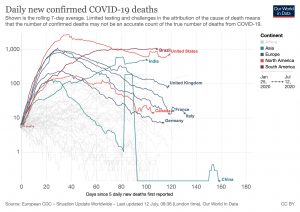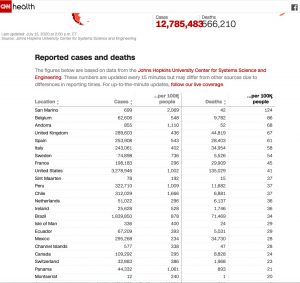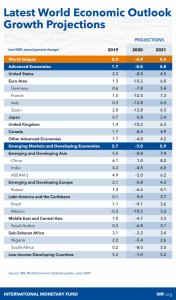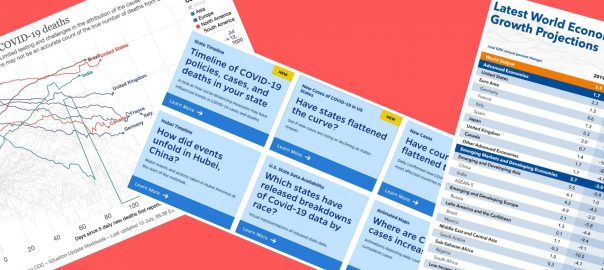Last week, I had the pleasure of conversing with Amb. Chas W. Freeman, Jr, on the “World After Covid” webinar series that Just World Educational has been running. Freeman, you may remember, was the man notably removed from consideration as Barack Obama’s first Director of National Intelligence because the pro-Israel lobby wanted to ensure that no-one with his record of occasional skepticism of their claims should ever get such a powerful job. He is also a thoughtful, widely experienced polymath who, among other career highlights, translated for Nixon during Nixon’s breakthrough 1972 visit to China and negotiated with Fidel Castro (in Spanish) over the withdrawal of Cuban and South African troops from Angola…
Our conversation (which you can watch here) started with a reference to an address he gave to some Saudi management trainees in mid-June. Specifically, a reference to two early points he had made in that address:
- The 500-year domination of the globe by Europe and Western culture has ended…
- The “American century” is behind us, as the United States trashes the world order it once sponsored… reenacts the opening stages of the late, unlamented Cold War with all-too familiar enemies, and separates itself from foreign allies, partners, friends, and followers.
Throughout the past four months, I have given a lot of thought to the “American decline” part of this equation. (This recognition was, indeed, the motivating spirit behind the whole of the “World After Covid” project, which my colleagues on the JWE board and I launched in early June.) But the first of those points that Freeman made– that what we are seeing is not just the precipitous decline of U.S. power but also the the end of a 500-year chunk of history in which “White” European and Euro-heritage powers have dominated the whole world order– is a much bigger one, the implications of which which will, of course, be correspondingly broader.
First, to underline the degree to which this observation is correct, let’s review a few key facts and figures:
 My first chart shows (mainly) the degree to which the United States has failed to bring Covid-19 under control in the way that several European countries (and certainly China) have. Be aware that: the y-axis is on a log scale; what the chart shows are 7-day rolling averages of daily new Covid deaths per country; and the x-axis marks “Days since 5 new daily deaths first reported” (Hence, China is further along than most other countries.). If you go to the “World in Data” web-page from which I took this image just now, you can get updated information and play around by putting other countries’ lines into the picture.
My first chart shows (mainly) the degree to which the United States has failed to bring Covid-19 under control in the way that several European countries (and certainly China) have. Be aware that: the y-axis is on a log scale; what the chart shows are 7-day rolling averages of daily new Covid deaths per country; and the x-axis marks “Days since 5 new daily deaths first reported” (Hence, China is further along than most other countries.). If you go to the “World in Data” web-page from which I took this image just now, you can get updated information and play around by putting other countries’ lines into the picture. Now, another chart, this one from CNN, which shows “Reported cases and deaths”, both absolute numbers and numbers per 100,000 people in the country. This one is also downloaded today, from here. I like to order this chart by the “Deaths per 100K people” column, as I did here, which gives an interesting snapshot of how severely each country’s population has been struck by Covid mortality. What I’ve shown is all the countries in which the deaths per 100K have been 20 or greater. Of the 23 countries in this group, all but six are either European or dominated by Euro-heritage people. This is a stunning finding, since these are all “rich” countries. At the head, absolute numbers-wise, is the United States, whose 135,029 deaths make up 26.8% of the entire (reported) global death-toll from Covid– though the U.S. constitutes less than 5% of the world’s population. Also of note in this listing: (a) Several EU countries have death rates considerably higher than the the United States; (b) Two Euro-heritage countries– Australia and New Zealand/Aotearoa– have death rates considerably lower: <1 per 100K; (c) So do China and some other East Asian countries; (d) The rates of incidence and mortality for several very low-income countries may well not have been fully reported/reportable.
Now, another chart, this one from CNN, which shows “Reported cases and deaths”, both absolute numbers and numbers per 100,000 people in the country. This one is also downloaded today, from here. I like to order this chart by the “Deaths per 100K people” column, as I did here, which gives an interesting snapshot of how severely each country’s population has been struck by Covid mortality. What I’ve shown is all the countries in which the deaths per 100K have been 20 or greater. Of the 23 countries in this group, all but six are either European or dominated by Euro-heritage people. This is a stunning finding, since these are all “rich” countries. At the head, absolute numbers-wise, is the United States, whose 135,029 deaths make up 26.8% of the entire (reported) global death-toll from Covid– though the U.S. constitutes less than 5% of the world’s population. Also of note in this listing: (a) Several EU countries have death rates considerably higher than the the United States; (b) Two Euro-heritage countries– Australia and New Zealand/Aotearoa– have death rates considerably lower: <1 per 100K; (c) So do China and some other East Asian countries; (d) The rates of incidence and mortality for several very low-income countries may well not have been fully reported/reportable. And now, a table. This time, from the IMF’s late-June projections for global economic prospects for all of 2020 and all of 2021. A number of things are notable here. Firstly, the IMF has always been a U.S.-dominated organization. It’s a key part of the global economic command-structure the U.S. created at the end of WWII. You can’t accuse it of being “anti-American”. Second, the IMF is now projecting that the U.S. economy– and the economies of all “advanced countries, that is, U.S. allies Europe, Japan, and Canada– will contract by 8% this year. The U.S. economy will then, the IMF projects, grow by 4.5% next year– which will still leave it 3.86% smaller at the end of 2021 than it was at the end of 2019. The IMF projects, meanwhile, that China’s economy will grow this year by 1% and next year by a further 8.2%.
And now, a table. This time, from the IMF’s late-June projections for global economic prospects for all of 2020 and all of 2021. A number of things are notable here. Firstly, the IMF has always been a U.S.-dominated organization. It’s a key part of the global economic command-structure the U.S. created at the end of WWII. You can’t accuse it of being “anti-American”. Second, the IMF is now projecting that the U.S. economy– and the economies of all “advanced countries, that is, U.S. allies Europe, Japan, and Canada– will contract by 8% this year. The U.S. economy will then, the IMF projects, grow by 4.5% next year– which will still leave it 3.86% smaller at the end of 2021 than it was at the end of 2019. The IMF projects, meanwhile, that China’s economy will grow this year by 1% and next year by a further 8.2%.
It’s also definitely worth underlining that the IMF’s economic projections are all extremely sketchy, especially as regards the further-out time periods. The body already, between April and June of this year, had to revise its projections considerably downward… and who know what will happen in the next two months?
To me, the broad picture is as follows:
We, the people of the United States, are still mired deep in our current biological, economic, and sociopolitical crisis with no indication of when it might end. (These three dimensions of the crisis are inextricably intertwined, as I have written about in this portion of Just World News, since May 1.) Because of the complete lack of any national leadership or national strategy, this crisis– in all its elements– might simply continue more or less as it is until both (a) one or more vaccines for the Coronavirus have been “discovered”, identified, tested, and deemed reasonably safe and effective, and (b) this vaccine or vaccines have been distributed and safely administered nationwide to, say, 60% or more the country’s population. This will almost certainly not happen any time before the end of 2021.
The only alternatives to acquiring and deploying an effective vaccine in this way would be that either (A) the national population could be persuaded to go (or go back) into a serious, multi-week lockdown, such as would starve the virus of the opportunity to propagate, or (B) the virus has spread so widely throughout the population that we do develop some form of “herd immunity”, despite ourselves and at the cost of possibly more than a million deaths from it, nationwide. Personally I would love it if the national government would institute a nationwide lockdown that has essential elements of other social planning baked into its design– such as ensuring that all U.S. residents have a safe place in which they can be quarantined; that food, internet, and other essential services and utilities are assured to them in a safe manner for the period of the lockdown; that enforcement be assured on a clear, comprehensive, and fair basis; and that national- and state-level decisions on all aspects of the lockdown be clearly communicated.
Six weeks should do it. And officials could also use that time to make coherent, fair plans for how a phased re-opening would follow.
But any such plan is inconceivable so long as Donald Trump is president. And even if he is replaced by Joe Biden, it is still very hard to see that a President Biden would be able to plan or implement such a project, come January. (And anyway, what state will the country be in, in January? I shudder to think of the deprivation we will see across the land by then.)
So I guess we are left with either Develop & Distribute the Vaccine, or just let the virus spread till a million Americans have died… and just imagine what other political and institutional breakdowns we will have seen by the time either of those things happens.
Further, as the economy, health status, and major institutions of the United States continue to crumble or implode over the next 18 months, the country’s traditional “allies” will be unable to offer any more than a little token help to us. Europe? Canada? Japan? Australia? There will be little any of them can do to help. Many will still be trying to extricate themselves from the aftermath of their own Covid crises. And given the massive role of the United States in world economy and society, our decline will drag nearly all of them down, too.
What we are looking at will almost certainly be, as Amb. Chas Freeman had noted, not just the end of the “American Century” but also the end of the “White” European countries’ 500-year-long domination of the world scene.
* * *
Throughout my life and increasingly over the past 20 years, I have pondered how it was that– starting back in the 16th century CE– that tiny country I grew up in, Britain, and a handful of other European countries came to dominate so very much of the rest of the world. A lot of it, clearly, had to with technological advances like improvements in shipping, in navigation, in armaments, and then, the Industrial Revolution. Domination of long-distance sea-lanes was clearly a crucial factor, and helps to explain why it was some countries on the Atlantic periphery of Europe took the lead in world domination: Britain, France, Spain, Portugal, Netherlands.
More recently, I’ve been reading two excellent books by Indian-heritage scholars who have helped put more pieces of the puzzle into place: Inglorious Empire: What the British Did to India, by Shashi Tharoor, and Empire of Guns: The Violent Making of the Industrial Revolution, by Priya Satia. Both are definitely worth reading! Tharoor’s book fleshes out a lot about the prolonged, serial atrocities the British committed against India. Satia’s, which I’m still only just starting, provides an intriguing new look at the role that gunmaking played in spurring the Industrial Revolution in Britain. Crucially, her argument is that it was not the case (as I had been taught in school) that the I.R. was the product of numerous plucky and creative British inventors who just happened upon all those inventions, but rather that it was government funding– particularly in terms of large-scale purchases by governmental and government-supported bodies (like the British East India Company)– that spurred and to a large degree also directed the development of gun technology and through that, the development of metallurgical and other gun-related technologies, across the board.
The British Empire was built and maintained, of course, on guns and the application of horrific, large-scale violence in a number of different ways. Priya Satia’s book promises to provide considerable new background information on that. (Also, sadly, on the leading role that British Quakers played in the gunsmithing industry, right through to the end of the 17th century, and perhaps thereafter.)
Anyway, at a time when the domination of the world by “White” European and Euro-heritage countries now seems to be coming crashing to the floor, it seems like a good time to examine the 500-year history of that domination with a view to better understanding it. And also, of course, so we can start to think about how to build a better, more humane and life-sustaining order for the next– what?– 500 years? Maybe at this point, I’d settle for a century.
